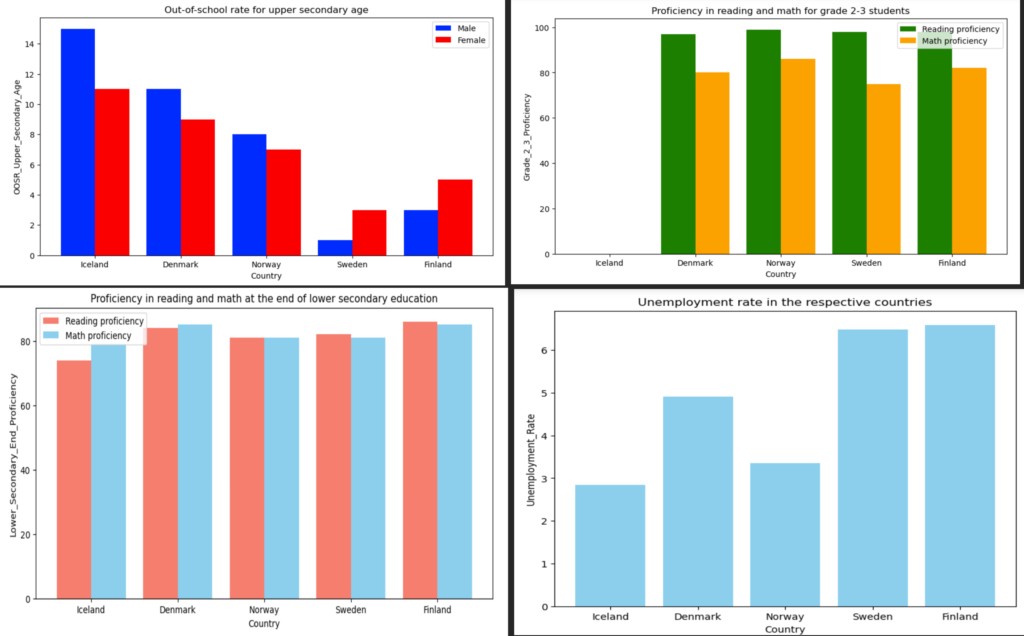In a world where education is often seen as a stepping stone to success, the Nordic countries stand as a testament to the power of a well-crafted education system. A recent analysis of educational data from these countries provides insights that are not just illuminating but also actionable for policy makers and educators worldwide. These insights highlight the significant role that education plays in shaping economic outcomes and promoting societal welfare. As we delve into my analysis, we uncover the reasons behind the Nordic success story and what the world can learn from it.

Globally speaking, several countries in America, parts of Europe, and Australia have higher proficiency levels than the rest of the world, as indicated by the bright yellow. However on the other hand, many countries in Africa, some in Asia indicates lower reading proficiency levels among the young students there.
Upon further research, we can see that this stark difference runs parallel to the countries developed status. More developed countries (Canada, Europe, Australia) have higher reading proficiency scores compared to those of developing countries (sub-Saharan Africa).
This disparity could be caused due to various factors like lack of educational resources, economic conditions (poor infrastructure), or even government policies (political instability).
Looking at the broader picture, the mean reading proficiency score for Grade 2-3 is approximately 21.98, indicating that on average, the reading proficiency scores are low across the sampled countries. This is a significant problem.
Children around the world are not acquiring basic reading skills during their critical early learning years, which are foundational for future educational success.

In the above graph, taking the example of Singapore – the reading and maths proficiency in grade 2-3 students is 97% and 93% respectively. This high rate has converted into the youths of the nation to be 100% literate. On the other hand, taking the example of Niger where a very low reading and maths proficiency rate (9%, 27%) has lead to only 51% of the youths being literate. This stark contrast clearly highlights the importance of emphasising education from the very beginning since it can make or break the countries future.
Furthermore, countries with low literacy rates struggle to develop a skilled workforce, potentially impeding their ability to attract investment, innovate and grow. This just continues the cycle of poverty and brings the phrase ‘the rich are getting richer and the poor are getting poorer’ to justice.
Looking at the brighter side, Latvia, the Netherlands, and Norway all have the highest reading proficiency score (99), which indicates the excellent performance in reading at the Grade 2-3 level in these countries.
Why?
They have emphasized upon early childhood education for everyone.
They have a well-funded system in place.
They have a high quality of teacher training.
Nordic Countries (Denmark, Norway, Sweden, Finland and Iceland) are well-known for their exceptional education systems as seen by the data visualization done below:

(credits: Veeti Koivuniemi)
The above graph are all indications of three important things:
- Education is a Key Driver of Economic Success
- Early Childhood Education is Fundamental for Long-Term Academic and Professional Success
- Equity in Education Leads to Balanced Societal Advancement (more elaboration on this coming up!)
Rambling off some statistics, Denmark, Finland, Norway, and Sweden all show very high reading proficiency scores for Grade 2-3, ranging from 97 to 99. This suggests that children in these countries are achieving excellent reading outcomes at a young age. By focusing on the formative years, these countries ensure that children build a solid foundation for future learning. Furthermore, the gross primary education enrollment rates for these Nordic countries are all around 100%, indicating that virtually all children in these age groups are enrolled in school. The strong start given to young students pays dividends throughout their academic and professional careers, setting them up for success in a competitive global landscape.
Additionally, enrollment rates in tertiary (higher) education are also high for these countries, ranging from approximately 67% to over 88%, demonstrating a strong emphasis on higher education and suggesting that a significant portion of the population pursues education beyond the secondary level. Moreover, the unemployment rates in these countries are relatively very low, (Iceland: 2.84%, Sweden: 6.48%).
Low unemployment rates is a sign of a well-educated workforce and a robust economy. This data further suggests that a well-educated workforce contributes to lower unemployment rates. Investment in education can lead to favourable labour market outcomes – the data reveals a clear link between educational attainment and economic indicators such as unemployment rates. Their investments in education correlate with strong economic health and the ability of their citizens to find gainful employment.
Compared to the global mean reading proficiency score of 21.98, the proficiency scores in Nordic countries are exceptionally high. This disparity highlights the success of the Nordic education systems and I strongly urge other regions to study and possibly adopting some of their educational policies and practices. Their approach to teacher training, educational funding, early childhood education, and social support systems are all areas that could be emulated.
Beyond foundational skills, the Nordic education systems excel at nurturing the capabilities required for innovation. Students are not only literate and numerate but also adept at applying these skills to solve complex problems. Such an education system breeds innovators and thought leaders who drive progress and competitiveness, especially in high-skill industries and sectors.
The Nordic countries have set a benchmark for educational excellence with their strategic focus on quality, equity, and early childhood education. As nations around the globe grapple with the challenges of equipping their youth for the future, the Nordics are a great example to follow!
All the data used above is taken from NIDULA ELGIRIYEWITHANA who created the dataset, “Introduction to World Educational Data”

